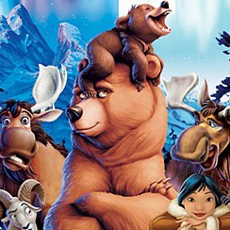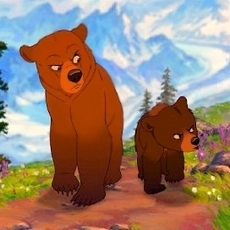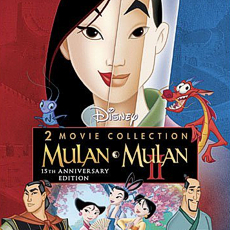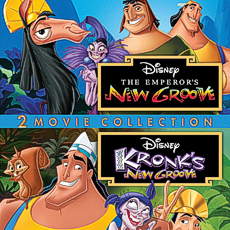Walt Disney Feature Animation, DisneyToon Studios (November 1 2003, August 29 2006), Walt Disney Home Entertainment (March 12 2013), Blu-ray Disc plus two DVDs, 85 and 73 mins plus supplements, 1080p high-definition 2.35:1 and 1.78:1 widescreen, DTS-HD Master Audio 5.1, Rated G, Retail: $39.99
Storyboard:
It’s The Lion King meets Pocahontas in Disney’s underrated Brother Bear, in which Kenai, the youngest of three new-agey brothers, is about to receive his “Totem”, an animal representation to which his character’s spirit is closely tied. Out on a hunt, brother Sitka is killed by a bear, and Kenai, trying to prove himself to his tribe, goes out alone to find and kill it. As he does, the Great Spirits of the sky step in, transforming Kenai into a bear himself, so that he can see the world through the other creature’s eyes. Meanwhile, third brother Denemi is convinced this “new” bear is responsible for also killing the missing Kenai, and vows to avenge them both…
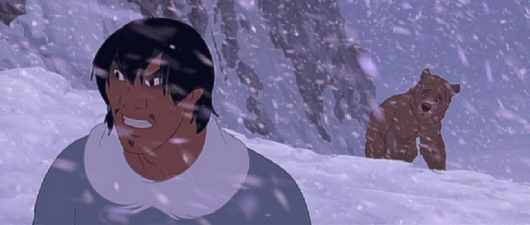
The Sweatbox Review:
Once destined to be Disney’s final foray into the traditionally created hand-drawn animated feature film medium that the Studio had been built upon, it’s somewhat ironic that Brother Bear has now come back to home video, in a new HD debut on Blu-ray, just as the company has confirmed there are no further hand-drawn features in development at Disney Animation. Bear would have followed Home On The Range into theaters and ended up being the Studio’s last traditional animation (for a while at least), but the powers that be from Disney-on-high commanded that the film be shorn of six-months production time and rush-released to coincide with the then-DVD release of The Lion King, in a desperate bid to create company synergy. Hey, both stories featured talking animals in the wild, right? Both had a stampede sequence? Music and songs from older British rockers? Check! I guess the thinking was that if people saw the Brother Bear trailer on Lion King’s DVD, then they’d go see that movie instead of a singing cow comedy, right? Well, kind of.
In the end, we need not have been too worried: Home On The Range did bring the curtain down on the art form that Walt himself had turned into a commercial behemoth, but it wasn’t too soon afterwards that the Studio acquired Pixar and its own head-honcho John Lasseter, who immediately set to work in retaining the very same process of making animated films with The Princess And The Frog. That film may not have been the kind of huge hit the earlier 1990s movies had been for the Studio (and the next effort, a frankly misguided effort based on the Winnie The Pooh characters, also failed to resonate with audiences, but for clearer reasons), but at least the Disney legacy was given a lifeline that meant classical Disney Animation wasn’t going to have gone out with balladeering bovines and the slightly whimpering memory of Brother Bear.
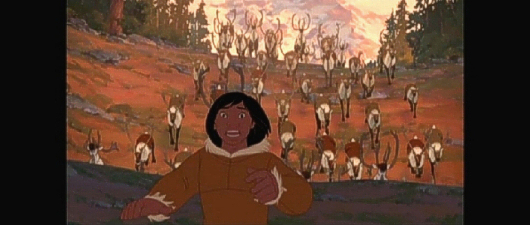
Not that there’s any actual problem with the entertainment value that Bear provides, but after the drama-lite of Mulan and the outrageousness of Lilo And Stitch, the film did bring the folks at Walt Disney Feature Animation-Florida back down to Earth with a great big thud – and with a bigger crash to come when they later found out this was to be their final outing. Looking back on it today, Brother Bear feels steeped more in the “serious, epic art” phase of Pocahontas and Hunchback’s mid-90s Disney (the result of the earlier Beauty And The Beast being taken seriously by the motion picture Academy and their Oscar nomination for Best Picture) rather than the fresh knockabout feel of One Hundred And One Dalmatians and The Jungle Book’s freewheeling ’60s Disney, or even the fun but broad animated films (Oliver & Company, Little Mermaid, Aladdin) of the late 80s and early 90s.
In fact, going back to that corporate synergy approach, it sometimes seems Brother Bear has been stitched together simply from successful elements from Disney’s past. It’s very much a film of two parts; not quite two halves, since the split doesn’t seem to be equal. There are a variety of changes that happen throughout the story, which actually work in the film’s favor, as well as against it. First and most noticeable is the switch from traditionally animated 1.85:1 aspect ratio to the full 2.35:1 look of CinemaScope, which accompanies Kenai’s transformation from human to bear. This is the first example of a ratio change in an animated film, though live action films have been pulling this trick for years, even as far back as MGM’s heyday, with the current Oz: The Great And Powerful continuing the tradition today). The actual change is handled well, although I still think the screen should have stretched wider during the transformation instead of waiting until after that event, when Kenai awakes the next day, dimming the effect of this moment, for me, ten-fold.
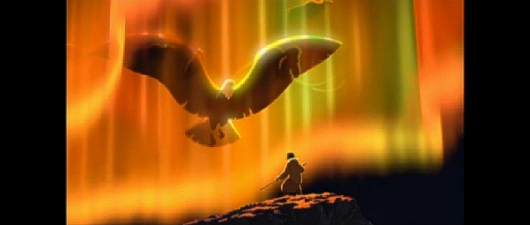
Nicer is the subtle but noticeable overall change in color palette, after the switch, to the wider-screen ratio. Assumedly because Kenai is now more at one with nature and therefore experiencing things with added detail, the color palette takes on an almost mind-numbing brightness, although, and despite an attempt to be bold, the backgrounds begin to look quite bland to me, almost approaching the overly exposed look of a DTV release, something that seems to have been toned down a little in this new HD remastering. Other changes that somewhat break the spell the film has on the audience up until this point also include the overall tone, which goes from that “serious, epic art” approach from human-Kenai’s screen time to a much more cartoony feel. In a reverse of Bambi’s cute-to-realism switch after the little deer loses his mother, the characters here are fluffier, with rounder designs, and their attitudes change too. This is primarily again because the bear-Kenai is experiencing these moments from the other side of the fence, where he can see first-paw what human-kind can do to the peaceful, fun-lovin’ naturalness of the animal world.
There’s also a great deal more reliance on comedy than from the opening human sections, and while all these swaps in tone do help in putting the audience in Kenai’s place, the fact that there are so many of them hurts the basic structure, with the last two-thirds of Bear almost becoming another type of film entirely until the wrap up at the end. This is also almost a case of Disney-by-numbers: the opening human sections are great, re-treading Pocahontas ground with mystical stories and elders who continue the legacy of their people, in this case Eskimos. There is, in truth, some fine story work here, and animation which really shows how the team at WDFA-Florida had developed since forming to work on their initial Roger Rabbit shorts assignments in the 1990s (Kenai’s brother Sitka’s face, just before he makes a fateful decision, is the stuff of what just makes Disney “Disney”). But against that, there seems to be an over reliance on tricks (comedy sidekicks, music montages, etc) that have helped previous Disney films scrape through, in Brother Bear they manage to stick out somewhat more than usual.

There is one cringe-worthy scene where, for no apparent reason, new-found-friend moose Rutt and Tuke decide to accompany Kenai and Koda on their quest, and I shuddered at the thought of the old comedy shtick playing throughout the rest of the movie. However, they come and go throughout and all too conveniently, arriving just at the right time to do their funny and then leaving in time, often without good reason, so as to never get irritating (though I’d have loved to see more of the similar ram duo characters). Thankfully, unlike more recent, celebrity-voiced animated films, the vocalists don’t overbalance the characters, with Rutt and Tuke pleasingly escaping being weighed down by their famous Canadian counterparts, Rick Moranis and Dave Thomas (any McKenzie Brothers fans out there?). In the lead role of Kenai, a now much more well-known Joaquin Phoenix is spot on, while one thing I do notice more and more whenever I see the film is how very few female characters there are in Brother Bear, leaving no room for any love interest subplots, itself probably a good thing in avoiding any further clichés.
Of course, being a Disney feature with 1990s sensibilities, Brother Bear needs songs, but composer Phil Collins doesn’t really help things feel fresh in the way he made Tarzan feel different and unique, even if he does provide several catchy tracks that help tell the story through song (and have ended up being mainstays on my car stereo). Also, for the first time, he’s also co-written the original score (with Tarzan composer Mark Mancina), leading to a tight weaving of song and score. To be honest, some of the lyrics border on the trite, with none of the depth that I felt propelled Tarzan up to the next level, but musically they’re great, powered by Collins’ usual thumping rhythms, as you might expect from an ex-percussionist, and surely the middle-eight from Welcome (“to our family…”) is one of the most beautiful and touching of any in the Disney canon.
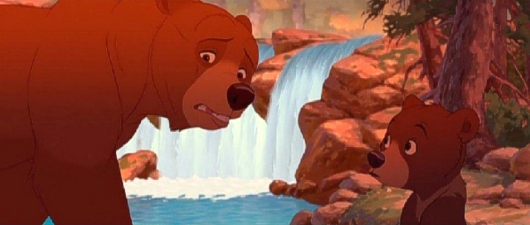
It’s good to see too that, although Collins wrote all the songs, he shares vocal duties with others, most notably Tina Turner, who sings the film’s opener. It may seem an obscure choice to have someone else sing this one song when Phil dominates so much of the rest of the soundtrack (although his version was heard in early teaser trailers before some fans were disappointed it wasn’t used in the final film), until one comes to realize that it helps the transformation divide even more by not having him come to the fore until Kenai is a bear, which is again subtle, and nicely played. It’s the smaller elements like these that mark Brother Bear out as being worth watching, rather than the overall consolidation of the more usual Disney ingredients…ingredients that found themselves being somewhat warmed up again for Pixar’s recent Brave, drawing comparisons to this earlier movie and not always coming off as its better. Yes, Bear can still feel “tried and tested” in places, but then on seeing it again I was also touched by several scenes.
The transformations that occur roughly half an hour in really do take Brother Bear in different directions, although it’s debatable which side of the divide makes for the more interesting viewing. It really is a film of two sides: the ending, where Kenai must make a final choice, seems not only predictable but contrived also, even if the film overall remains a thrilling entertainment that can only be enjoyed by its audience. In the ten years since its original release, its reputation seems to have survived intact, and even perhaps grown a little, and those looking for Disney’s unique quality of storytelling, traditional animation technique and all-round entertainment value should not be disappointed.
Is This Thing Loaded?
Coming right on the cusp of Disney’s withdrawal from the lavish two-disc DVD sets of old, but before the company started to issue their animated films in slimmed down editions with fewer supplements, Brother Bear’s initial set was artificially inflated by the option of a second version of the film (as you’ll read below in the video specs section). Here, with native widescreen the HD norm, there’s no need for that so it has been dropped and replaced with the film’s direct-to-video sequel Brother Bear 2, making up this 2-Movie Collection edition and running a full 73 minutes. As opposed to most of the pre-quel, mid-quel, also-quel settings of the routine Disney video follow-ups, Bear 2 actually continues the story as a true second chapter, also enlisting some major talent from the first film and maintaining the feature animation quality that the company’s satellite studio in Australia had been approaching before their switch to churning out the continuous line of Tinker Bell titles as if this was some kind of purgatory to make up for the likes of Cinderella II.
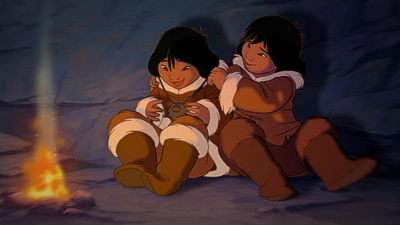
There’s even some real character progression in Brother Bear 2, with any complaints at the lack of female characters or romantic subplot in the first movie answered in the film’s overall story arc, which finds an old flame of Kenai’s, Nita, about to be married. However, the spirits believe Kenai and Nita should have been together had Kenai not followed the path that transformed him into a grizzly, and bestow Nita with the power to converse with animals. Finding Kenai deep in the woods and needing to get home, the two must travel together to finally break the connection between them…however, the sometimes treacherous journey presents various obstacles and opportunities for them to realize how much they still mean to one another, resulting in the need for sacrifice in order for at least one of them to be able to follow their true path and find happiness. With a basic set-up like that, Brother Bear 2 isn’t nearly as treacly as it sounds, and coming near the end of DisneyToon’s development as a quality animation house, this is perhaps one of the very few such films that could have been theatrically released and stand shoulder to shoulder with its predecessor (indeed, the Project Firefly studio founded by members of the shuttered Florida unit is credited with additional production services).
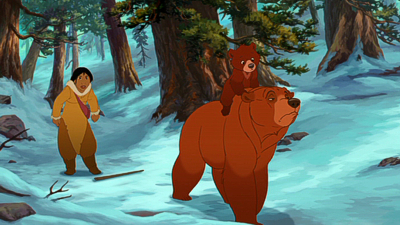
It’s true that Bear 2 doesn’t quite share the budget of the first film, but the artists down under had by this time become so adept at forging the Feature Animation style that many would be hard-pressed to see a difference (for instance, there’s none of the “marker pen” thick outlines of a Pocahontas II or the simplified keyframing that just marks out the likes of Mulan II as something lesser than Feature quality). Where these DTVs often failed was in the story department, but despite a slightly less epic and more childlike nature, Brother Bear 2 is actually quite robust, continuing the tale and bringing back the same characters with (largely) the same voice cast. Before becoming Enchanted, Patrick Dempsey sits in for Phoenix as Kenai, but it’s thankfully a fairly transparent switch, with Moranis and Thomas back as moose Rutt and Tuke, given their own amusingly romantic subplot. Added to this is the not inconsiderable Mandy Moore as Nita, as well as a handful of Collins-styled new songs performed by Grammy winner Melissa Etheridge, perhaps drafted in as a way to further bring a female sensibility to the series.
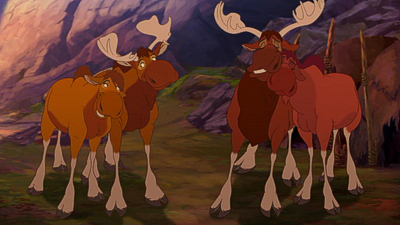
As underrated as a DTV title as its bigger brother was theatrically, Brother Bear 2 places up high with An Extremely Goofy Movie and Lilo & Stitch 2 as being faithful continuations of their original outings: not only the kind of half-decent video films that, say, Scamp’s Adventure or Simba’s Pride were, but bona fide follow-ups that might otherwise have deserved suitably appropriate theatrical status. As such this is one time when the inclusion of a Disney animated film’s video sequel isn’t such a bad choice, and even better is that it thankfully doesn’t mean the original DVDs’ supplements have been banished to the dreaded virtual vault Disney saddled us with on some previous Blu-ray updates. Once again optional is Paths Of Discovery: The Making Of Brother Bear, a series of twelve featurettes grouped under four categories: Beginnings, Welcome To The Family, Mirror To The World and Music And Songs, with a handy Play All option that runs all the pieces as a seamless 45-minute documentary.
It’s a really good documentary, too, and one that doesn’t gloss over the production process even if, understandably, the troubles at the Florida Studio are left untouched. We get to hear mostly from directors Aaron Blaise and Robert Walker, who perhaps say all that they would want to here and forgo a commentary, as well as Phil Collins, the voice cast and Roy Disney in his credited guise of Vice Chairman of The Walt Disney Company and Chairman of Disney Animation. Much discussion is had over the story origins, the directions the film went in, the planning of the songs and score, and on “how great” then Studio chief Michael Eisner’s “hands on” approach helped shape the film and “made it better”. In hindsight it’s easy to read between the lines at what was going on at the Studio – and what would soon happen, of course – but this is still a strong, now archival production document. The directors pop up again an Introduction to three Deleted Scenes, shown in storyboard and rough animation, and lasting just over eleven minutes. Again, there’s a Play All option, the sequences ranging in length; all run on the long side and the reasons why they were either shortened or deleted are pretty clear.
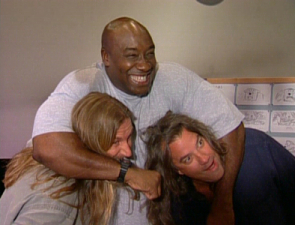
Koda’s Outtakes (2:45) features more of the same as found in the main feature’s closing credits, but this time they’re more centered on the fluffing of lines and scenes going awry. Created in the Pixar tradition (which itself was pioneered in an earlier Warners Bugs Bunny cartoon), I found these clips funny, but with too much of the “crew” having a say. Although a “crew” was often heard in the Pixar outtakes, practically every shot here has a cry of “marker” and “err, can we fix that please” at the front and end – a little off putting and which impacted on the humor for me. The clip is presented in 2.35:1, although this is now windowboxed in the 4:3 transfer, but what’s nice is that these are fully animated shots. There’s also a “never-before-heard” (except for the last DVD!) deleted track, The Fishing Song (3:45), which was later changed to the Welcome cue, and that would have played where Kenai meets the other bears at the salmon run. Intro’d by Collins and presented against storyboarded art, the song features temp track vocals and some audio spots, and is very much in the same vein as the more rambunctious sections of Welcome, but lacking that effective middle-eight which brings it all home for Kenai. Fun enough, but wisely switched for the more majestic track featured in the movie.
Also carried over is the later Transformation Song, as written by Collins (2:25). In the movie, the English lyrics were translated into Innuit and sung by the Bulgarian Women’s Choir, but here we have a chance to see (via subtitles) what the lyrics were as originally written. It’s presented semi-music video style, with scenes from the film played against clips of the Choir in the recording studio, and very interesting in its own right. There’s more music with the On My Way Sing-Along, which plays the four minute clip with the words on screen to – hey! – sing along with, and staying with Collins is the four minute Look Through My Eyes Music Video, a much better proposition than many of Disney’s music clips which sometimes only last for a matter of seconds. Here, we get the full song, with a typically glossy video promo that shows Collins recording the song as well as a healthy amount of shots from the movie. As with all this bonus material, it’s in standard definition only, the 4:3 image matted into the 16:9 frame, meaning that a lot of content, such as this letterboxed 1.85:1 video, is now windowboxed on all sides, although I don’t have a huge issue with this.
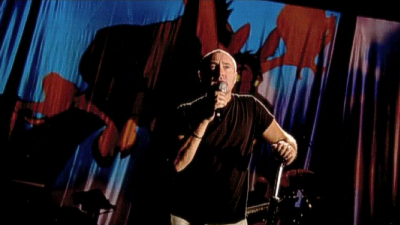
Bear Legends is a brief three-minute collection of Native American Tales, with Tanana telling us such myths as How The Bear Came To Be, and The Boy Who Lived With Bears. Nicely rendered in stone wall paintings, the feature has little to do with the film, but shares themes and its visual approach. Moving from the visual side to the audio, Making Noise: The Art Of Foley is a quick look (3:15) at how the sound effects for an animated movie are put together, hosted by Jeremy Suarez (Koda). What starts off as being dangerously close to turning into fluff (and I’m not talking bear fur here!) actually plays as a pretty fun little excursion into the sound studio, and those who have always wondered where “Foley” got its name from will find the answer in here! Demonstrating the lack of an incoherent menu navigation system, it’s then back to the visuals for a ten-minute Art Review with art director Robh Ruppel and Bear-Kenai animator Byron Howard narrating a montage of photos and concept art stills, and showing the evolution of the film and its art.

In an early version of the film, an older bear named Grizz was to be Kenai’s guide, which might have taken off the curse of the perhaps too “kid-friendly” Koda sidekick and made it a deeper film. Although the clip is video based, the viewer can pause it at any time to take in the character designs and paint work that went into the production. Nicely put together, I found this to be a really great way to step through the images, and the added commentary opens up a lot more than what can be taken in simply by sifting through images alone. Finally, there’s an otherwise fairly redundant Rutt And Tuke Commentary, although the silhouetted characters that were video-matted onto the DVD’s presentation, Lion King 1½ style, are no more. As an audio-only experience, the track is still pretty fun, though how funny you find it will rely deeply on whether you can stand vocalists Moranis and Thomas speaking babble for an hour and a half. I’ve been a fan of theirs since the McKenzie Brothers era, and never felt they got the just recognition for pioneering the brand of humor that Mike Myers used (combined with Bill And Ted’s “inspiration”) for Wayne’s World, but even I found their improvised yakking fairly tiresome here.
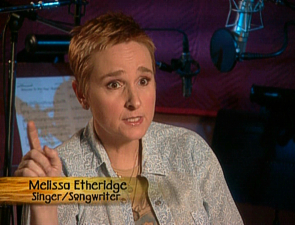
Character chats have never really been my thing, and although these two do actually let you in on a few pointers on the film’s creation, it’s mostly filler (for every valid point they make, there are at least 20 or so humorous faux comments, such as “hey, is that Yoda?”), although the dropping of the much promoted (at the time) “see them onscreen” hook doesn’t really detract from the experience since it was only used sporadically through the feature; however, I do find it a bit of a shame when a decent DVD idea isn’t carried over or offered the right amount of work to reproduce in the supposedly even flashier Blu-ray format. From the sequel’s original DVD, Behind The Music Of Brother Bear 2 was the lone featurette to be found there and it’s the lone bonus to be found supporting the film here too. Concentrating on Etheridge’s genuine credentials and the deeper than usual tone her work brings to what is essentially a children’s direct-to-video movie, this eight minute-plus talking heads and clips package is a serious piece that proves even the most commercial of franchise extensions still have groups of dedicated artists bringing their top game to the table.
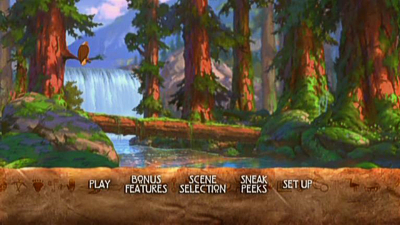
If I could have asked for any more, it would be for the theatrical teaser and the two full trailers that warmed audiences up to see the film in theaters, but since they weren’t on the original DVD either it’s no surprise to find they’re not here either. On the enclosed Brother Bear and Brother Bear 2 DVDs (basically replicas of the original discs complete with outdated previews), Koda’s outtakes, the sing-along songs, music video, a couple of set-top games, the commentary (with overlaid moose visuals intact!), Bear Legends, Foley and art review, plus the Etheridge featurette and a Bear 2 game are featured, respectively. Across all discs, Sneak Peeks feature for The Little Mermaid’s 3D Diamond Edition, Monsters University and the first full trailer for the semi-Pixar-less Planes (a smart move on their part: if it’s a hit they can say it was inspired by Cars, if it flops then it’s all Disney’s fault for stretching out the franchise), plus previews for Epic Mickey: The Power Of Two, Mulan, SuperBuddies, Return To Never-Land, the next, untitled Tinker Bell outing and other Disney promo spots.
Case Study:
Without a slipcover accompanying the original DVD release, Brother Bear gets a welcome upgrade in that respect with this new Blu-ray, fashioned as per the usual Disney 2-Movie Collection style by having the sleeve semi-divided into two halves to showcase characters from both films alongside the main protagonist. Since both films here feature the same characters the mix is less obvious and is largely based upon an original poster image and the DVD’s artwork, the most significant – but again almost transparent – alteration being the addition of the sequel’s Nita on the right side above the title treatment. The back of the embossed slip and replicated sleeve pay almost no attention to the DTV in its synopsis and since both films share so much the inclusion isn’t as noticeable and is actually pretty welcome. Nice!
Ink And Paint:
With a very “warm” color palette, many criticized the original DVD of being soft visually even though I found it to be a faithful representation, but there should be no such qualms here! A fantastic digital transfer looks great, preserving the 2.35:1 theatrical ratio throughout, meaning that the film’s earlier and narrower screen dimensions (of around 1.85:1) are printed within the 2.35 ratio. This has the effect of the film’s opening appearing “windowboxed”, with black matting featuring around the whole image until the ratio widens out after Kenai’s transformation. Have no fear: this is exactly as the film was shown theatrically and as the filmmakers intended it to be seen, since when the image broadens out it really does provide more width to the vistas.
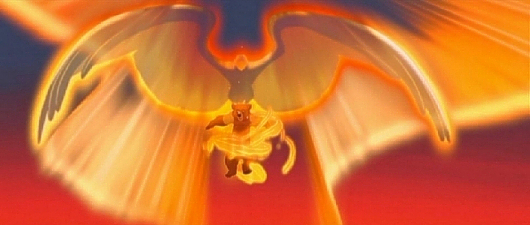
On the enclosed DVD, the package suggests two ratios are offered: the correct 2.35:1 framing as well as a “family friendly widescreen” remnant from the old DVD – actually only the 1.66:1 framing is here (being Disc One from that old set). Here there’s a slight cropping of a slight sliver left and right of the opening scenes to give an overall 1.66:1 presentation, a ratio that is retained after the transformation and that loses much more of the film’s hard-matted 2.35 composition – the frame stays put at 1.66, panning-and-scanning the wider ratio for picture information. Back in the DVD days this was actually a fairly nice way to present the film, but now we’re all 16:9’d up it does feel like a bit of a throwback and, as before, I could still detect some edge-enhancement trying to give the film more definition and there’s a banding effect on the bears’ color grades, but at least its inclusion means Rutt and Tuke’s silhouetted commentary is back.

These anomalies are much less detectable in the new HD transfer, which is as spotless as if the film had been released last year. The direct-to-video follow-up doesn’t have such screen dimension shenanigans to circumvent since it was produced with a natural 16:9 friendly ratio of 1.78:1, close enough to the original movie’s earlier scenes so as to retain a connection and thankfully providing a nice widescreen composition that compliments the first film rather than feeling like a pale knock-off. Sometimes the “lesser” titles in the Studio’s library can only get a moderate treatment and although Bear wasn’t the biggest hit it wasn’t an embarrassment either, and kudos is most certainly due to Disney for treating both Brother Bear and its DTV sequel with appropriate respect.
Scratch Tracks:
As one of the few Disney movies to get a DTS track in its original DVD issue, there isn’t such a great leap in terms of Bear’s soundtrack. It’s still a very lively track, though, even if the fully enveloping mix doesn’t quite reach demo material (it’s not actually that kind of movie), But it is a very pleasing aural experience, especially when the score really kicks in, or when there is an action scene to be had; the transformation effects sound great and the deep bass lends a powerful punch to the more dramatic moments. French and Spanish subtitles and Dolby Digital 5.1 tracks are also included and match the original English quite well.
Final Cut:
Featuring a largely overlooked Disney original and its own direct-to-video follow-up, this new 2-Movie edition of Brother Bear is a very smart package, retaining the majority of previous extras. There’s nothing new here, but the supplements come from a time when such things were put together in a classy way as only Disney can and they should please the young and even the oldest animation nuts out there. The original film may not be a classic in the true Disney sense, but it has stood up well in the ten years since being released and had enough of the humor and heart that we came to expect from the Studio’s more recent films. The lighter-weight DTV, despite a predictable simplicity in its less complicated storyline, also has much to recommend it, not least a good couple of exciting sequences.
That there’s nothing new here is only slightly disappointing: after a rush of Blu-ray updates that contained some new extras it seems Disney has slipped into a basic mode of providing catalog title releases that basically recycle older material but that should actually be welcomed rather that criticized – whenever they retain the most essential of bonuses as previously released. This set does that just fine: those who love Disney animation will find much to enjoy (it’s debatable on which film in a renewed comparison with the more recent and similar Brave would come out best, although I know which way I lean) and, in this case, should agree that the Studio has done a fine job preserving their artists’ work for old and new home audiences.
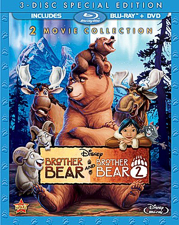 | ||
 |


